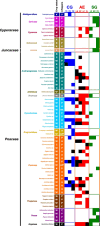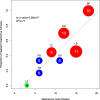Increase of niche filling with increase of host richness for plant-infecting mastreviruses
- PMID: 39717705
- PMCID: PMC11665825
- DOI: 10.1093/ve/veae107
Increase of niche filling with increase of host richness for plant-infecting mastreviruses
Erratum in
-
Correction to: Increase of niche filling with increase of host richness for plant-infecting mastreviruses.Virus Evol. 2025 Jun 16;11(1):veaf046. doi: 10.1093/ve/veaf046. eCollection 2025. Virus Evol. 2025. PMID: 40525130 Free PMC article.
Abstract
Now that it has been realized that viruses are ubiquitous, questions have been raised on factors influencing their diversity and distribution. For phytoviruses, understanding the interplay between plant diversity and virus species richness and prevalence remains cardinal. As both the amplification and the dilution of viral species richness due to increasing host diversity have been theorized and observed, a deeper understanding of how plants and viruses interact in natural environments is needed to explore how host availability conditions viral diversity and distributions. From a unique dataset, this study explores interactions of Mastrevirus species (family Geminiviridae) with Poales order hosts across 10 sites from three contrasting ecosystems on La Réunion. Among 273 plant pools, representing 61 Poales species, 15 Mastrevirus species were characterized from 22 hosts. The analysis revealed a strong association of mastreviruses with hosts from agroecosystems, the rare presence of viruses in coastal grasslands, and the absence of mastreviruses in subalpine areas, areas dominated by native plants. This suggests that detected mastreviruses were introduced through anthropogenic activities, emphasizing the role of humans in shaping the global pathobiome. By reconstructing the realized host-virus infection network, besides revealing a pattern of increasing viral richness with increasing host richness, we observed increasing viral niche occupancies with increasing host species richness, implying that virus realized richness at any given site is conditioned on the global capacity of the plant populations to host diverse mastreviruses. Whether this tendency is driven by synergy between viruses or by an interplay between vector population and plant richness remains to be established.
Keywords: Mastrevirus; Poales; agroecosystem; ecology; host–pathogen interaction network; viral metagenomics.
© The Author(s) 2024. Published by Oxford University Press.
Conflict of interest statement
None declared.
Figures



Similar articles
-
Metagenomics reveals the structure of Mastrevirus-host interaction network within an agro-ecosystem.Virus Evol. 2023 Jul 6;9(2):vead043. doi: 10.1093/ve/vead043. eCollection 2023. Virus Evol. 2023. PMID: 37475836 Free PMC article.
-
Exploring the diversity of Poaceae-infecting mastreviruses on Reunion Island using a viral metagenomics-based approach.Sci Rep. 2019 Sep 3;9(1):12716. doi: 10.1038/s41598-019-49134-9. Sci Rep. 2019. PMID: 31481704 Free PMC article.
-
Molecular diversity, geographic distribution and host range of monocot-infecting mastreviruses in Africa and surrounding islands.Virus Res. 2017 Jun 15;238:171-178. doi: 10.1016/j.virusres.2017.07.001. Epub 2017 Jul 4. Virus Res. 2017. PMID: 28687345
-
From Spatial Metagenomics to Molecular Characterization of Plant Viruses: A Geminivirus Case Study.Adv Virus Res. 2018;101:55-83. doi: 10.1016/bs.aivir.2018.02.003. Epub 2018 May 7. Adv Virus Res. 2018. PMID: 29908594 Review.
-
What determines species richness of parasitic organisms? A meta-analysis across animal, plant and fungal hosts.Biol Rev Camb Philos Soc. 2014 Feb;89(1):123-34. doi: 10.1111/brv.12046. Epub 2013 Jun 20. Biol Rev Camb Philos Soc. 2014. PMID: 23782597 Review.
Cited by
-
To be or not to be a virus: A novel chimeric circular Rep-encoding single stranded DNA virus with interfamilial gene exchange illustrates the considerable evolutionary capacity of ssDNA viruses.PLoS One. 2025 Aug 18;20(8):e0309278. doi: 10.1371/journal.pone.0309278. eCollection 2025. PLoS One. 2025. PMID: 40824887 Free PMC article.
-
Improvement of Nanopore sequencing provides access to high quality genomic data for multi-component CRESS-DNA plant viruses.Virol J. 2025 Mar 18;22(1):78. doi: 10.1186/s12985-025-02694-x. Virol J. 2025. PMID: 40098028 Free PMC article.
References
-
- Almeida-Neto M, Guimarães P, Guimarães PR et al. A consistent metric for nestedness analysis in ecological systems: reconciling concept and measurement. Oikos 2008;117:1227–39. doi: 10.1111/j.0030-1299.2008.16644.x - DOI
-
- Baudin P. Problèmes Pathologiques de la Canne à Sucre et du Maïs à L’île de la Réunion. IRAT, Rapp Mission 1976;28:32.
LinkOut - more resources
Full Text Sources
Research Materials

